The Samsung Galaxy S7 and S7 edge Review: Part 2
by Joshua Ho on July 5, 2016 8:00 AM ESTCamera Architecture and UX
In general, camera has become probably the single biggest point of differentiation between smartphones at this point. As smartphones are often the only camera that most people carry on a day to day basis, the rear camera on a smartphone really cannot be a disappointment relative to the competition. While we can talk about how much a front-facing camera matters in terms of quality, it’s pretty safe to say that for photos and videos that are worth saving will be taken with the rear-facing camera.
While post-processing and a number of other factors are going to have a huge impact on the overall camera experience, the foundation that makes it possible to deliver a great camera is always going to start at the hardware.
| Samsung Galaxy S Cameras | ||||
| Galaxy S6 Galaxy Note5 |
Galaxy S7 | |||
| Front Camera | 5.0MP | 5.0MP | ||
| Front Camera - Sensor | Samsung S5K4E6 (1.34 µm, 1/4.1") |
Samsung S5K4E6 (1.34 µm, 1/4.1") |
||
| Front Camera - Focal Length | 2.2mm (22mm eff) | 2.1mm (21mm eff) | ||
| Front Camera - Max Aperture | F/1.9 | F/1.7 | ||
| Rear Camera | 16MP | 12MP | ||
| Rear Camera - Sensor | Sony IMX240 Samsung S5K2P2 (1.12 µm, 1/2.6") |
Sony IMX260 Samsung S5K2L1 (1.4 µm, 1/2.6") |
||
| Rear Camera - Focal Length | 4.3mm (28mm eff) | 4.2mm (26mm eff) | ||
| Rear Camera - Max Aperture | F/1.9 | F/1.7 | ||
In the case of the Galaxy S7, Samsung has done something that I thought they’d never do, which is move backwards in resolution in order to improve pixel sensitivity. In the case of the Galaxy S7, Samsung has moved from the Sony IMX240/Samsung S5K2P2 to the Sony IMX260/Samsung S5K2L1 sensor, with a 1.4 micron pixel size relative to a 1.12 micron pixel pitch in the previous generation. This means that there’s a 56% increase in sensitivity per pixel. Assuming the same process technology, this does improve low light performance significantly. While to some extent it’s true that improved CIS (CMOS image sensor) technology can alleviate the downsides of smaller pixels, on the same technology you have to reduce your fill factor/active sensor area. The other problem is that while read noise on the sensor does reduce per pixel as you reduce pixel size, the overall sensor read noise trends upwards. This means that the region in which the CIS noise is primarily limited by shot noise is going to be smaller as you reduce pixel size. Shot noise is an unavoidable reality of existence, to the extent that even our eyes can see this “visual snow” if ambient light is sufficiently dim.
However, in the case of the Galaxy S7 I suspect that there’s more to the story, because the dual pixel AF system means that for each 1.4 micron pixel each pixel needs two photodetectors. In order to make phase detection work, there has to be sufficient spatial separation to make this system work properly, so some of the benefit of these larger pixels will inevitably be eaten up in order to enable PDAF that works in basically all lighting conditions.
The other notable change here is that the Galaxy S7 uses an even wider f/1.7 aperture. Unfortunately, in Samsung's efforts to try and make the module thinner they've made the focal length slightly shorter than before which results in an effective focal length of 26mm. This and the wider aperture could lead to compromises as light is entering the optics at a more extreme angle than before.
With these basics covered, we can move on to a discussion of the user experience. While in the past it was easy enough to just take some still shots on a tripod, a holistic view of camera quality really needs to take into account far more than just the end result. A poorly designed camera application with low resolution, low frame rate preview, improper preview aspect ratio, poor control layout, and other issues can easily make it difficult, if not impossible to get the photo that you want. These issues are thankfully getting less common, but these problems can make it almost impossible to recommend a phone for its camera, no matter how good the results are.
In the case of the Galaxy S7, the camera application is a nice upgrade over the Galaxy S6 at launch, but for the most part nothing is really different this go around. I’m not going to spend too much time here, but the short story is that I don’t think that Samsung is doing anything wrong here, and things are pretty much as good as they’re going to get.
While leaving it at that would be enough, I want to recognize some of the improvements that Samsung has implemented here. The major improvement here is that Pro mode is finally useful, as this mode now allows for adjusting auto-exposure and AF targets, in addition to EV, shutter speed, ISO, white balance with 100K granularity, and manual focus. The one notable shortfall here is that Samsung only allows 800 ISO max in manual ISO mode when the true maximum is 1250. For better or worse though, that’s the only notable problem I encountered with the camera app itself. It’s easy to think that Samsung hasn’t done anything notable here, but this is more a testament to the execution of design more than anything else.
However, before we move on to image quality testing, we can take a look at our focus and capture latency tests. For those that are unfamiliar, this is a fairly simple test designed to see how long it takes for a phone to focus and capture a scene on our standard ISO test chart in good lighting conditions, which can give a fairly good idea for best case latencies.
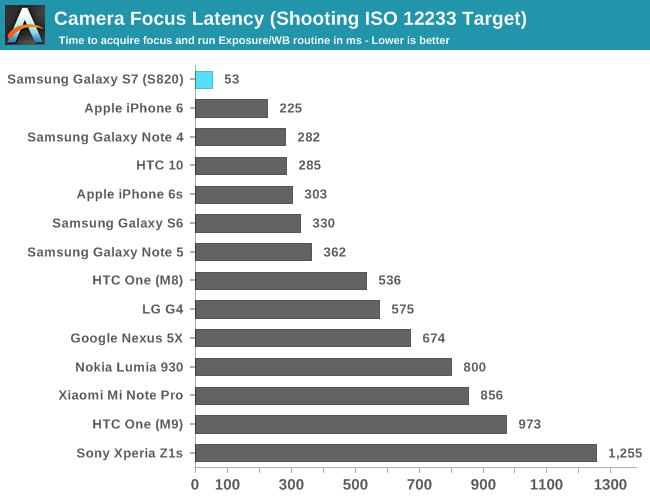
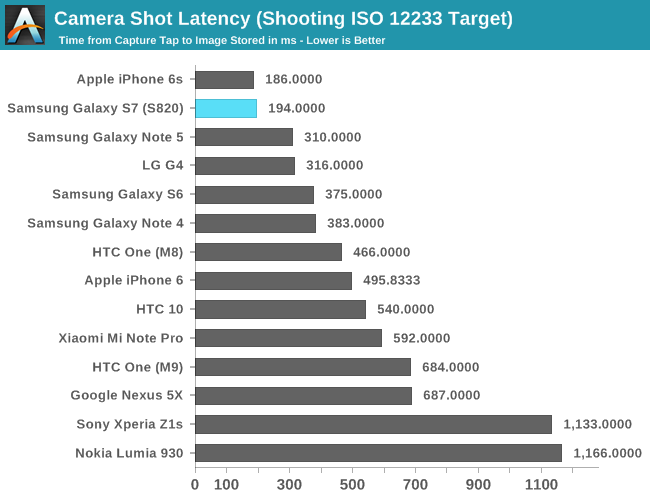
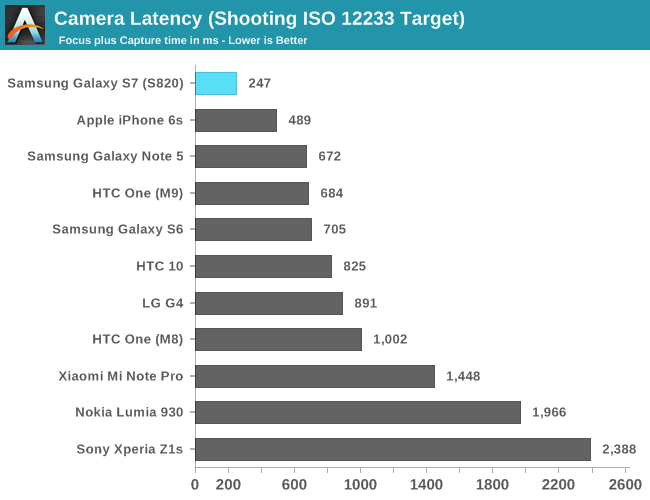
It’s probably not a surprise, but the Galaxy S7 is really, absurdly quick to take photos and focus. There is nothing out there that can realistically match the dual pixel AF system in the Galaxy S7, especially once you get into low light scenarios where traditional PDAF systems are overwhelmed by noise that can’t be easily canceled out. Samsung’s sheer prowess in semiconductor design and manufacture is really showing here, even in the best case.


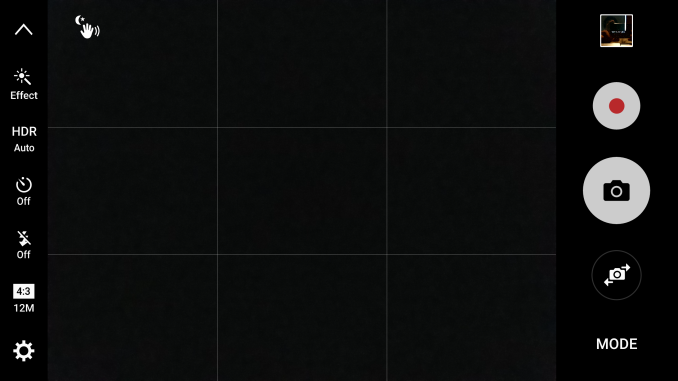
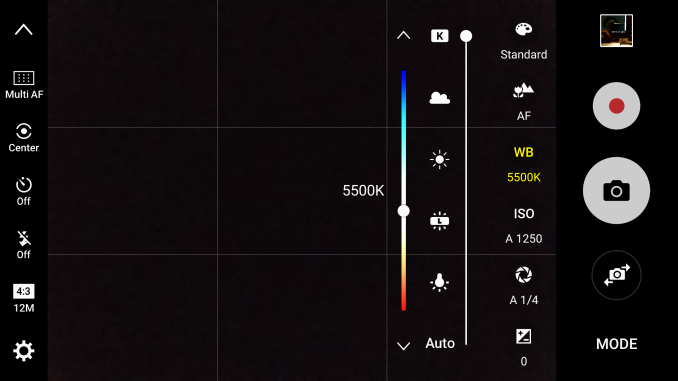
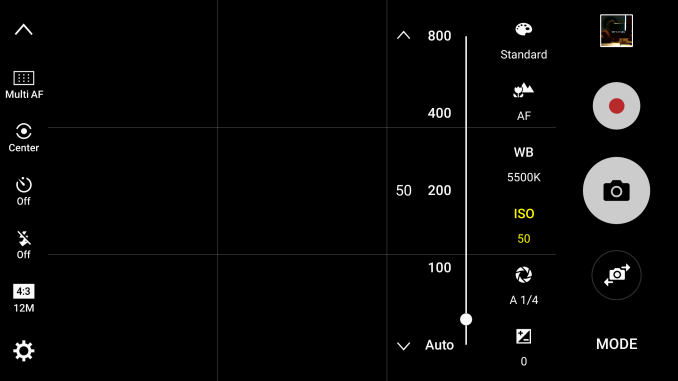








266 Comments
View All Comments
Ryan Smith - Tuesday, July 5, 2016 - link
"Some battery tests missing Exynos values or Edge values."This is a pretty common misconception, but AnandTech isn't located in a single, central office, which impacts how we do testing. Most tests are done in isolation anyhow, so it's not an issue, but LTE is by its very nature a location-sensitive test. In this case the International (Exynos) S7 is with our international editor, Andrei, which means that it wasn't able to be tested alongside the North American (Snapdragon) S7.
more-or-less - Tuesday, July 5, 2016 - link
Doesn't make up for the fact that even after 4 months, this review looks rushed and incomplete. One of the most underwhelming reviews I have read in this site, and it's obvious that the quality of articles have gone down massively.I now only trust Andrei to give proper articles, others seem to be reading from a old script.
Chris_m1296 - Wednesday, July 6, 2016 - link
how did the exynos version manage 2800 on the slingshot es 3.1 unlimited test? mine only manages 2200 and even futuremark lists the exynos version at 2200.Newair - Tuesday, July 5, 2016 - link
The S7 edge is without a doubt the worst phone I have ever owned.1st of all, it's texture is very slippery
In fact if I hadn't dropped it within 5 minutes of buying it and doing some damage, I would have returned them by now. Yes them. Bought 2.
Constantly charging battery
Perhaps it's just the way I hold the phone, but constantly touching something on the screen with a finger and off it goes in a different direction
Keyboard is miserable. More often than not, when I press 0 I get 9. Have never had this much trouble typing.
In all, if I could afford it, I would through thing out the window.
dawheat - Tuesday, July 5, 2016 - link
This might be one of the worst reviews I've read on Anandtech and the slide though gradual, is persistent.The S7 Edge is the more exciting device and one of the few genuinely unique Android devices but the review generally ignores it outside of a few token areas.
For example, how many times does the writer have to state that battery life is good only due to size? Who really cares how it accomplishes class leading battery life, considering that it's still much more compact AND lighter than the 6S Plus. Yet the S7 Edge gets incredibly faint praise for battery life - only one of the most important aspects of a device.
And with the comment about it being a heavy phone, I'm befuddled how a 10% heavier phone in the 6S Plus gets a free pass.
The camera review also ends up showcasing nerds in basements where only perfectly still photos matter- in the real world for example, trying to get pictures of your moving kids is hugely dependent on focus speed and the difference between a mushy blur and actually capturing a memory.
Oh and of course, not actually running browser benchmarks on the stock browser that comes with the device...again.
But all together just bleh - compared to someone like Andrei, this writer is just balls.
more-or-less - Tuesday, July 5, 2016 - link
"But all together just bleh - compared to someone like Andrei, this writer is just balls."-- Agree on this entirely. Compared to deep-dive articles that Andre produces, this review is just worthless. How someone could approve this review after 4 months of 'investigation' is beyond my understanding? Better get another reviewers, this Joshua guy doesn't insipre any level of confidence.
How did he manage to get a post in Anandtech to review phones is still a mystery.
They took 4 months to publish this, SMH :(
retrospooty - Tuesday, July 5, 2016 - link
Yup. Totally agreed.msh - Tuesday, July 5, 2016 - link
HiThis snapdragon browser you write you need to install to get acceptable performance on the SD820 variant, where is one able to obtain that?
I cant find it in google play.
variab1e - Tuesday, July 5, 2016 - link
While I greatly value these reviews. They lack what every review I've found lacks , a test of the radio's RF performance. First and foremost these are phones, or in the broadest sense, wireless communications devices; what could be more important than its ability to send and receive data?! I really respect Anandtech for its technical accuracy, and think that adding this component to its reviews would help to differentiate it from other vanilla sites. A lab setup to a standard candle signal source and then real world tests would be nice, but even the latter alone would be useful!anactoraaron - Tuesday, July 5, 2016 - link
hmmm..."The Galaxy S7 and S7 edge are still great phones, but the difference between a $400 phone and a $700 phone are these details when phones like the OnePlus 3 are providing almost the same product at a dramatically reduced price. There are clear points of differentiation between the Galaxy S7 and OnePlus 3 or Mi5 in terms of features, but I don’t think it’s enough to be worth the $300"
Unless you like looking at a 1080 pentile amoled and think that Samsung Pay, a wildly better display, VR capability (not mentioned in this review - although just about everyone who got this device got a VR headset for free) and water resistance isn't worth $300. After owning the G4 and the ridiculously terrible panel on it for a year I was REALLY happy paying just north of $100 more than I did for the G4 at launch time for the S7 Edge.
Seriously I feel betrayed that we all had to wait this long for this review and even given all this time, it feels rushed and as if the reviewer didn't really want to do it, especially the tone at the end. It's like he's saying, "yeah it's the best phone for android - if that matters at all - but it still feels 'meh' to me just like everything else these days. You are better off with the iPhone."
What exactly has apple done to innovate and drive this industry forward the past 2 years? Force touch? Squeeze identical components into a smaller device?
Seriously I don't know how a review like this would be published on Anandtech. It's reviews like this for what has been clearly the best android phone of the year is how this site gets constantly called out for bias. And this time for good reason.